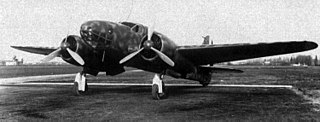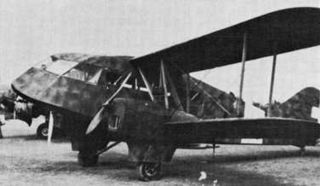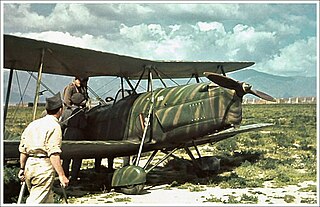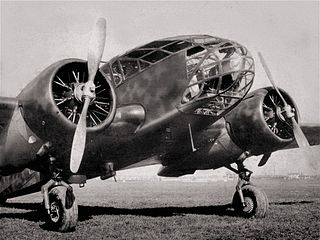
The MB.200 was a French bomber aircraft of the 1930s designed and built by Societé des Avions Marcel Bloch. A twin-engined high-winged monoplane with a fixed undercarriage, over 200 MB.200s were built for the French Air Force, and the type was also licence built by Czechoslovakia, but it soon became obsolete, and was largely phased out by the start of the Second World War.

The Breda Ba.65 was an Italian all-metal single-engine, low-wing monoplane used by Aviazione Legionaria during the Spanish Civil War and Regia Aeronautica in the first half of World War II. It was the only Italian ground-attack aircraft that saw active service in this role. It saw service almost exclusively in the North African and Middle-Eastern theatre. In addition to more than 150 aircraft operated by the Italian forces, a total of 55 were exported and used by the air forces of Iraq, Chile and Portugal.

The Savoia-Marchetti S.73 was an Italian three-engine airliner that flew in the 1930s and early 1940s. The aircraft entered service in March 1935 with a production run of 48 aircraft. Four were exported to Belgium for SABENA, while seven others were produced by SABCA. The main customer was the Italian airline Ala Littoria.

The Fiat CR.20 was an Italian biplane fighter used during the 1920s and 1930s. Designed by Celestino Rosatelli, it represented an intermediate step from the early biplane CR.1 and the later, successful series CR.30, CR.32 and CR.42.

The Dewoitine D.27 was a parasol monoplane fighter aircraft designed by Émile Dewoitine in 1928.

The Meridionali Ro.37 Lince was a two-seater Italian reconnaissance biplane, a product of the Industrie Meccaniche Aeronautiche Meridionali (IMAM) company. It appeared in 1934 and had a composite structure of wood and metal. The aeroplane first saw operational duty in the Second Italo-Ethiopian War (1935–1936) and Spanish Civil War (1936–1939), and during the Second World War it saw duty on almost all fronts, except for Russia and the English Channel. It followed the Ro.1 as the main reconnaissance aircraft for the Italian Army.

The Caproni Ca.310 Libeccio was an Italian monoplane, twin-engine reconnaissance aircraft used in World War II. Derived from the similar Ca.309, it had its combat debut during the Spanish Civil War and took part in the earlier phases of World War II in Libya. Some were used in attack groups as a temporary replacement for the unsatisfactory Breda Ba.65. The last Ca.310 was retired by the Italian Air Force in 1948.

The Breda Ba.44 was a biplane airliner developed in Italy in the mid-1930s and which saw limited military service when impressed into the Regia Aeronautica as transports.

The Potez 540 was a French multi-role aircraft of the 1930s. Designed and built by Potez, it served with the French Air Force as a reconnaissance bomber, also serving with the Spanish Republican Air Force during the Spanish Civil War. Although obsolete as a bomber, it remained in service in support roles and in France's overseas colonies at the start of World War II.

The Caproni Ca.313 was an Italian twin-engine reconnaissance bomber of the late-1930s. It was a development of the Ca.310. Its variants were exported to several other countries.

The Dewoitine D.1 was a French single-seat fighter aircraft of the 1920s, built by the French industrial company Dewoitine.

The Caproni Ca.73 was an Italian airliner produced during the 1920s which went on to serve as a light bomber in the newly independent Regia Aeronautica.

The Caproni Ca.113 was an advanced training biplane produced in Italy and Bulgaria in the early 1930s. Designed as a follow-on to the Ca.100, it was a more powerful and robust aircraft capable of aerobatics. It was a conventional design with two cockpits in tandem, single-bay staggered wings of equal span, and mainwheels covered by large spats.

The Caproni Ca.164 was a training biplane produced in Italy shortly prior to World War II. It was a largely conventional biplane intended as a follow-on to the Ca.100 and sharing that aircraft's layout with a slightly smaller upper wing.

The Caproni Ca.311 was a light bomber-reconnaissance aircraft produced in Italy prior to and during World War II.

The Stinson Voyager was an American light utility monoplane built during the 1940s by the Stinson Aircraft Company.

The Caudron C.440 Goéland ("seagull") was a six-seat twin-engine utility aircraft developed in France in the mid-1930s.

The Wibault 7 was a 1920s French monoplane fighter designed and built by Société des Avions Michel Wibault. Variants were operated by the French and Polish military and built under licence for Chile as the Vickers Wibault.

The terms "Aviación Nacional", "Fuerza Aérea Nacional" and "Ejército Nacional del Aire" refer to military air units supporting General Franco against the Second Spanish Republic in the Spanish Civil War and includes:

The Kaproni Bulgarski KB-11 Fazan was a 1940s Bulgarian army liaison and utility monoplane built by Kaproni Bulgarski, a subsidiary of the Italian aviation conglomerate Società Italiana Caproni.





















